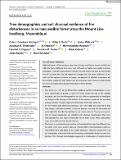| dc.contributor.author | Courtney-Mustaphi, Colin | |
| dc.contributor.author | Platts, Philip | |
| dc.contributor.author | Willcock, Simon | |
| dc.contributor.author | Timberlake, Jonathan | |
| dc.contributor.author | Osborne, Jo | |
| dc.contributor.author | Matimele, Hermenegildo | |
| dc.contributor.author | Osgood, Hanniah | |
| dc.contributor.author | Muiruri, Veronica | |
| dc.contributor.author | Gehrels, Maria | |
| dc.contributor.author | Bayliss, Julian | |
| dc.contributor.author | Marchant, Rob | |
| dc.date.accessioned | 2025-04-22T11:44:58Z | |
| dc.date.available | 2025-04-22T11:44:58Z | |
| dc.date.issued | 2024-10-24 | |
| dc.identifier.uri | https://dspace.nm-aist.ac.tz/handle/20.500.12479/3070 | |
| dc.description | This research article was published in the Journal of Plants, People, Planet, Volume 7, Issue 1, 2024 | en_US |
| dc.description.abstract | Societal Impact Statement
Highland forests of Mozambique have been strongly modified by human activities for millennia. Some highlands have sheer rock cliffs and are highly inaccessible to people and appear relatively undisturbed. Evidence from the forest and soils of inaccessible Mount Lico show that the fire regime has changed over the recent millennia. As climate and fire regimes continue to change, management of highland ecosystems will be crucial to sustain the high biodiversity and mountain-water resources that provide key ecosystem services to people living close to these forests.
Summary
The sheer rock cliffs of the Mount Lico inselberg, northern Mozambique, is relatively inaccessible to people. A 0.57 km2 forest covers the top of the isolated mountain, and the tree demographics and soil offer an opportunity to investigate the long-term fire ecology of the forests of the western, leeside of the mountain and potential for changing regional hydroclimate of the Late Holocene.
On the western side of the mountaintop, a 20 × 20 m plot was surveyed for tree taxa, heights and bole diameters. A 220 cm deep pit was dug into the forest soil and analysed to describe the soil texture and carbon content. Charcoal was quantified on sieved subsamples and classified into charcoal morphologies that were then grouped by how readily entrainable on an index score. Three radiocarbon dates were collected from pieces charcoal.
The forest is a combination of montane and woodland tree taxa that differed from the older, more mesic eastern side and reflected differential disturbance patterns. The reddish loam soils dated to the Middle Holocene. Charcoal was present in all soil subsamples and varied little until increasing consistently during the past millennium. The charcoal morphologies suggested a combination of locally derived charcoal and charcoal derived from the surrounding lowlands with the latter increasing in the past centuries.
Few Holocene paleoenvironmental records have been developed from tropical soils in Africa and are useful in locations that do not host lakes and wetlands. Both tree demographics and soil charcoal suggest that changing forest disturbance regimes began during the past millennium. An understanding of history informs future conservation and appropriate management of these special places. | en_US |
| dc.language.iso | en | en_US |
| dc.publisher | John Wiley & Sons | en_US |
| dc.subject | Charcoal morphology | en_US |
| dc.subject | Disturbance ecology | en_US |
| dc.subject | Embers | en_US |
| dc.subject | Forest fires | en_US |
| dc.subject | Refugia | en_US |
| dc.subject | Taphonomy | en_US |
| dc.title | Tree demographics and soil charcoal evidence of fire disturbances in an inaccessible forest atop the Mount Lico inselberg, Mozambique | en_US |
| dc.type | Article | en_US |

